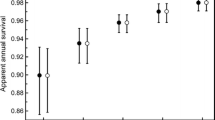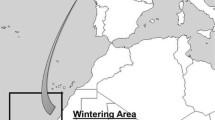Summary
In a location-independent simulation, Krill frequency and weight are modelled in 0.5 mm length classes. Population dynamics are defined by time- and length-dependent birth, growth and death rates. In a steady state (constant death rate of 98.7% p. a.) Krill frequency and weight oscillate by a factor of 32 and 3, respectively. Larval catch curves from German Antarctic Expeditions and published mortality rates for older Krill suggest a hyperbolic form of the survival function with age (i.e. mortality decreases with increasing body length). A Krill fishery can be simulated indirectly through manipulation of the mortality rate or through direct elimination of individuals. For example, a complete elimination of the upper length classes does not lead to extinction even if performed each year before the spawning season, as long as the size at fist capture is greater than 45 mm. The Antarctic Krill seems to be a classical example of r-selection with its high fertility, high mortality and large stock fluctuations.
Similar content being viewed by others

References
Argentesi F, De Bernardi R, Di Cola G (1974) Mathematical models for the analysis of population dynamics in species with continuous recruitment. Mem Ist Ital Idrobiol 31:245–275
Astheimer H, Krause H, Rakusa-Suszczewski S (1985) Modelling individual growth of the Antarctic Krill Euphausia superba Dana. Polar Biol 4:65–73
Bengtson JL, Laws RM (1985) Trends in Crabeater seal age at maturity: an insight into Antarctic marine interactions. In: Siegfried WR, Condy PR, Laws RM (eds) Antarctic nutrient cycles and food webs (Proc 4th SCAR Symp Antarct Biol). Springer, Berlin Heidelberg New York, pp 667–675
Beverton RJH, Holt SJ (1956) A review of methods for estimating mortality rates in fish populations, with special references to sources of bias in catch sampling. Rapp P-V Réun Cons Int Explor Mer 140:67–83
BIOMASS (1980) FIBEX Implementation and Co-ordination Meeting Report, Dammarie-les-Lys, France, 4–6 June 1980. BIOMASS Rep Ser 13:22 pp
Brinton E, Antezana T (1985) Structures of swarming and dispersed populations of Krill (Euphausia superba) in Scotia Sea and South Shetland waters during January–March 1981, determined by Bongo nets. J Crust Biol 4:45–66
Brinton E, Townsend AW (1984) Regional relationships between development and growth in larvae of Antarctic Krill, Euphausia superba, from field samples. J Crust Biol 4:224–246
Croxall JP, Prince PA, Ricketts C (1985) Relationships between prey life-cycles and the extent, nature and timing of seal and seabird predation in the Scotia Sea. In: Siegfried WR, Condy PR, Laws RM (eds) Antarctic nutrient cycles and food webs (Proc 4th Scar Symp Antarct Biol). Springer, Berlin Heidelberg New York, pp 516–533
Denys CJ, McWhinnie MA (1982) Fecundity and ovarian cycles of the Antarctic Krill Euphausia superba (Crustacea, Euphausiacea). Can J Zool 60:2414–2423
Fraser FC (1936) On the development and distribution of the young stages of krill (Euphausia superba). Discovery Rep 14:3–192
Freedman HI, Strobeck C (eds) (1983) Population biology. Lecture notes in biomathematics vol. 52. Springer, Berlin Heidelberg New York, 440 pp
Hamner WM (1984) Aspects of schooling in Euphausia superba. J. Crust Biol 4:67–74
Hempel G (1983) FIBEX — An international survey in the Southern Ocean: review and outlook. Mem Nat Inst Polar Res Tokyo 27:1–15
Hempel G (1985) Antarctic marine food webs. In: Siegfried WR, Condy PR, Laws RM (eds) Antarctic nutrient cycles and food webs (Proc 4th SCAR Symp Antarct Biol). Springer, Berlin Heidelberg New York, pp 266–270
Herman AW, Sameoto DD, Longhurst, AR (1981) Vertical and horizontal distribution patterns of copepods near the shelf break of Nova Scotia. Can J Fish Aquat Sci 38:1065–1076
Jackowska H (1980) Krill monitoring in Admiralty Bay (King George Island, South Shetland Islands) in summer 1979/80. Pol Polar Res 1:117–125
Jazdzewski K, Dzik J, Porebski J, Rakusa-Suszczewski S, Witek Z, Wolnomiejski N (1978) Biological and populational studies on Krill near South Shetland Islands, Scotia Sea and South Georgia in the summer 1976. Pol Arch Hydrobiol 25:607–631
Kawakami T, Doi T (1979) Natural mortality of krill and density in swarms. In: Doi T (ed) Comprehensive report on the population of Krill, Euphausia superba, in the Antarctic. Tokai Reg Fish Res Lab, pp 19–22
Krebs CJ (1972) Ecology: the experimental analysis of distribution and abundance. Harper and Row, New York, 694 pp
Longhurst AR (1976) Interactions between zooplankton and phytoplankton profiles in the eastern tropical Pacific Ocean. Deep-Sea Res 33:729–754
Mackintosh NA (1972) Life cycle of Antarctic Krill in relation to ice and water conditions. Discovery Rep 36:1–94
Mackintosh NA (1973) Distribution of post-larval Krill in the Antarctic. Discovery Rep. 36:95–156
Mackintosh NA (1974) Sizes of Krill eaten by whales in the Antarctic. Discovery Rep 36:157–178
Marschall S, Mizdalski E (1985) Euphausiid larvae in plankton samples from the vicinity of the Antarctic Peninsula, February, 1982. Ber Polarforsch 21:47 pp
Mauchline J (1965) The larval development of the euphausiid Thysanoessa raschii (M. Sars). Crustaceana 9:31–40
Miller DGM, Hampton I, Henry, J, Abrams RW, Cooper J (1985) The relationship between krill food requirements and phytoplankton production in a sector of the Southern Indian Ocean. In: Siegfried WR, Condy PR, Laws RM (eds) Antarctic nutrient cycles and food webs (Proc 4th SCAR Symp Antarct Biol). Springer, Berlin Heidelberg New York, pp 362–371
Nast F, Siegel V, Harm U, Pietschock D, Kane J, Dimmler W, Magas B (1985) Fischereibiologische Untersuchungen bei Elephant Island und in der Bransfield Straße. Ber Polarforsch 25:50–54
Pianka ER (1970) On r- and K-selection. Am Nat 104:592–597
Piatkowski U, Hempel I, Rakusa-Suszczewski S (1984) FIBEX cruise zooplankton data. Ber Polarforsch 16:53 pp
Quetin LB, Ross RM (1984) School composition of the Antarctic Krill Euphausia superba in the waters west of the Antarctic Peninsula in the austral summer of 1982. J Crust Biol 4:96–106
Ricker WE (1975) Computation and interpretation of biological statistics of fish populations. Bull Fish Res Board Can 191:382 pp
SCAR (1977) Biological investigations of marine Antarctic systems and stocks, vol 1. Research proposals
Siegel V (1982) Relationship of various length measurements of Euphausia superba Dana. Meeresforschung 29:114–117
Siegel V (1985) On the fecundity of Antarctic krill, Euphausia superba (Euphausiacea). Arch Fischereiwiss 36:185–193
Steele JH, Henderson EW (1984) Modeling long-term fluctuations in fish stocks. Science 224:985–987
Stepnik R (1982) All-year populational studies of Euphausiacea (Crustacea) in the Admiralty Bay (King George Island, South Shetland Islands Antarctic). Pol Polar Res 3:49–68
Venrick EL, McGowan JA, Mantyla AW (1973) Deep maximum of the photosynthetic chlorophyll in the Pacific Ocean. US Fish Bull 71:41–52
Author information
Authors and Affiliations
Additional information
Contribution No. 1 of the Alfred-Wegener-Institute for Polar and Marine Research, Bremerhaven, Federal Republic of Germany
Rights and permissions
About this article
Cite this article
Astheimer, H. A length class model of the population dynamics of the Antarctic Krill Euphausia superba dana. Polar Biol 6, 227–232 (1986). https://doi.org/10.1007/BF00443399
Received:
Accepted:
Issue Date:
DOI: https://doi.org/10.1007/BF00443399



